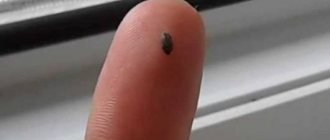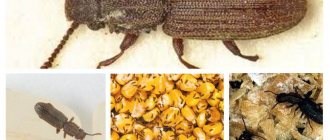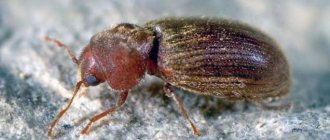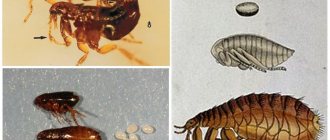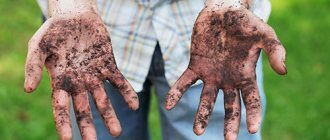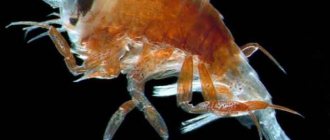Fish food
For many decades, pet fish lovers have been using daphnia as food for their aquarium pets. Even in Soviet times, these small crustaceans were caught by aquarists in natural reservoirs. It is clear that they had to know exactly where daphnia lives. Then the caught crustaceans were used not only live, but also frozen and dried. Of course, it is quite difficult to keep a large number of them at home, which is why many try to freeze daphnia during the period of its mass reproduction in nature. If we talk about the nutritional value of frozen food, it is practically in no way inferior to live crustaceans. Nowadays you can easily purchase frozen daphnia in pet stores, so such independent preparation is becoming a relic of the past.
Origin of the species and description
Photo: Daphnia
The genus Daphnia was described in 1785 by O.F. Muller. There are about 50 species of Daphnia, and many of them have significant differences from others. Daphnia longispina, described by the same Müller, is used as the type species.
Daphnia is divided into two large subgenera - Daphnia proper and Ctenodaphnia. The latter differ in a number of characteristics, for example, the presence of a notch in the head shield, and in general have a more primitive structure. But this does not mean that they occurred earlier: fossils date the origin of both to approximately the same time.
Video: Daphnia
The first representatives of branchiopods appeared about 550 million years ago, among them were the ancestors of daphnia. But they themselves arose much later: the oldest fossil remains date back to the Lower Jurassic period - that is, they are approximately 180-200 million years old.
These are not as ancient times as one might expect from relatively simple organisms - for example, fish and birds appeared much earlier. But, like other representatives of the superorder Cladocera, even in those days daphnia were similar to those of today, and in this they differ from more highly organized organisms of the same antiquity.
At the same time, one should not think that daphnia do not evolve: on the contrary, they have high evolutionary variability and adaptability, and constantly give rise to new species. The final formation of the Daphnia genus occurred immediately after the extinction at the end of the Cretaceous period.
Reproduction of crustaceans
If you look at the process of reproduction of these tiny crustaceans from a human point of view, it is very unusual. Females of this species have a so-called brood chamber, which is reliably protected by the edge of the shell and located on the back. When favorable conditions are created around, the female lays 50-100 unfertilized eggs in this cavity, where they develop. It is curious that only females hatch from these eggs and safely leave the chamber. After just a few days, the process repeats again, and young, grown and mature females will join this rapid reproduction process. That is why in summer, where daphnia lives, the water seems to turn reddish. The reservoir is simply teeming with this plankton. When the end of summer comes, the air and water temperatures drop, males appear and fertilize females, which produce eggs with a denser shell. These fertilized eggs are called ephippia. Their distinctive feature is their ability to withstand winter frosts and drying out of water bodies, and they can be carried with dust. With the onset of spring and warmth, females hatch from them, and the life cycle repeats again.
Reproduction and dispersal
Daphnia brood chamber with embryos
Ephippium Daphnia
(
Daphnia
) and a newborn female, just hatched from a resting egg
Most daphnia (like other cladocerans) are characterized by cyclic parthenogenesis. In favorable conditions (for example, in summer in non-drying puddles and shallow reservoirs), only parthenogenetic females are present in daphnia populations. From their unfertilized diploid eggs, the next generations of females develop. Since parthenogenesis in daphnia is ameiotic, their reproduction is clonal (populations consist of clones - the offspring of individual females). The development of embryos during parthenogenesis occurs in the brood chamber under the shell and is accompanied by several molts. Then the young crustaceans emerge from the brood chamber (direct development).
In the fall or before the reservoir dries up, males develop from the same unfertilized eggs (as a rule, all individuals of the same litter have the same sex). Thus, sex determination in Daphnia is purely environmental.
The transition to bisexual reproduction in species from large bodies of water usually requires exposure to two stimuli: a decrease in temperature and a decrease in daylength. It is hypothesized that these and other stimuli act by reducing the female's food intake. Male daphnia are smaller in size and differ significantly from females in the structure of the first antennae and thoracic legs. They swim faster than females and mate with them, attaching themselves to the rear edge of the shell. Fertilization in Daphnia is internal.
In recent years, it has been shown that the development of males can be induced by adding to the medium the juvenile hormone of crustaceans methyl farnesoate, as well as analogues of the juvenile hormone of insects—the insecticide fenoxycarb[4].
During the period of bisexual reproduction, some females give birth to males, while others at the same time form resting, or ephippial, eggs. They are formed by meiosis and require fertilization to develop. After fertilization, they also exit into the brood chamber, the covers of which thicken and form a special chitinous chamber - the ephippium (ephippium). Most Daphnia species have two eggs in the ephippium; in some Australian species, often classified as a separate genus Daphniopsis
, there is one egg in the ephippium.
In species of the subgenus Daphnia,
the long axes of the eggs are perpendicular to the dorsal edge of the ephippium; in species of the subgenus
Ctenodaphnia
, they are parallel to it or inclined at a slight angle.
Egg development continues until the gastrula stage, then they enter suspended animation. During the next molt, the female sheds the ephippium, which in some species usually sinks to the bottom, while in others it floats on the surface of the reservoir. When laying effipium, females of some species (for example, D. pulex
) often die. Together with ephippiums, daphnia eggs are carried by the wind, spreading on the paws of mammals, on the paws and feathers of birds, as well as in their intestines. It has also been shown that floating ephippiums can stick to the body of smooth bugs taking off from the surface of the water and be carried by them [5], and more often smooth ephippiums are carried by smaller ephippiums. Eggs in a chemically resistant shell inside the ephippium can remain viable after passing through the intestines of birds and fish. They usually also withstand freezing and prolonged drying. It has been shown that resting daphnia eggs can survive and develop for a long time in solutions of toxic salts (for example, mercuric chloride HgCl2) at a concentration of poisons thousands of times higher than the maximum permissible concentration [6]; after the egg shell ruptures, the hatched embryos in such solutions immediately die.
Habitat
After we have learned what daphnia is, the habitat of these representatives of the planktonic genus should also become known to us, because probably many of those who read this article are lovers of pet fish and want to have such information. So, you can find these tiny crustaceans in stagnant bodies of water, for example, lakes, ponds, as well as water holes, ditches and even puddles. Often, places where they gather in large numbers are ideal for harvesting daphnia yourself. You can identify such a place quite easily: where daphnia lives, the water most often has a gray-green or reddish tint. Their food consists of ciliates, bacteria, and plant plankton.
Such different daphnia
Those wishing to catch daphnia themselves must take into account how sensitive they are to light. In bright light, crustaceans will try to go deeper. There are different types of Daphnia. The most common crustacean found in the middle zone is Daphnia magna. The female reaches a length of 6 mm, but the male is only 2 mm. They usually live 110-150 days and in one clutch they produce up to 80 eggs, which grow within 4-14 days. The smallest crustaceans reach only 1.5 mm in size and mature within 24 hours, but they have litters every 1-2 days, up to 53 eggs.
REPRODUCTION OF DAPHNIA PULEX
Asexual reproduction
Daphnia reproduce by cyclic parthenogenesis, and Pulex is no exception. This form of reproduction is characterized by alternating unisexual reproduction, that is, the reproduction of similar individuals and, at certain times, sexual reproduction, through haploid eggs that must be fertilized.
Parthenogenesis - the so-called "same-sex reproduction" or "virgin reproduction" - is one of the forms of sexual reproduction of organisms, in which female reproductive cells (eggs) develop in an adult body without fertilization.
Unfertilized eggs (up to several dozen per clutch) develop into females, and in response to unfavorable environmental conditions - into males.
Sexual reproduction
In response to unfavorable environmental conditions that may cause the pond to freeze or dry out, the same female may produce resting haploid eggs, which, when fertilized by the male, are covered with a protective membrane, the ephippium. These resting eggs enter a diapause phase and are able to withstand periods of unfavorable environmental conditions for long periods of time. Hatching is triggered in response to certain stimuli, such as increases in photoperiod and temperature. Crustaceans from resting eggs develop exclusively into females.
How are they good for fish?
Why do aquarium fish lovers always try to feed them daphnia? Everything is very simple. Regardless of whether these crustaceans are freshly frozen or freshly caught, their stomach is usually full of plant food, and this is so useful for aquarium fish that are deprived of a natural diet. This is why daphnia must be present in the aquarium. Despite the fact that the daphnia shell is not digestible, it serves as an excellent ballast substance. Thanks to it, the intestines of fish are activated, which are not able to fully move in the aquarium. For aquarium fish that have not yet grown up, representatives of the smallest daphnia - moina, which is popularly called "live-bearer" - are simply ideal.
If you plan to catch crustaceans yourself, you must take into account that where daphnia lives, there is a consistent change in the population of crustaceans. For fishing, a fabric net is used, the cells of which must correspond to the desired catch. Some experienced “fishermen” advise fishing with a net with very small cells, and only then sorting the food by size through a sieve with different cells. You can fish starting in spring until a crust of ice appears on the reservoir. For such an event, a coast protected from the wind is usually chosen in calm weather in the morning or evening. It is ideal if the lighting is dim. Then daphnia, the habitat for which will thus become favorable, will rise to the upper layers.
How to dilute at home
When starting to grow freshwater organisms, you should first prepare a suitable container. In addition, you must know how to create all the necessary conditions for these individuals. It is how to properly breed daphnia at home that will be discussed later in the article.
Growing vessel or aquarium
A container with a volume of 15-20 liters is ideal for growing “live food”. When selecting a vessel, take into account the following instructions:
- choose a material that does not release hazardous chemicals into the water (for example, synthetic polymers). The ideal container is a glass vessel or an aquarium;
- if you are using a simple glass vessel, the area in contact with air should be extremely large. This condition is required for natural gas exchange and the supply of oxygen to small crustaceans;
- if you still choose a metal container, it should not be made of stainless steel;
- If you plan to keep a vessel with crustaceans indoors with bright lights or outdoors under bright sunshine, take a container with a minimum volume of 40 liters.
In aquariums you can breed fish such as: guppies, surgeon fish, arowana, discus, gourami, platies, astronotuses, cockerel fish, veiltails, clown fish, lalius, ancistrus, platies, catfish, barbs and parrots.
Physical conditions
Next, we will consider the physical conditions required for successful breeding of daphnia.
- Temperature . Crustaceans adapt to a wide range of temperatures. The ideal temperature is +18-22 °C. Daphnia pulex perfectly withstands fluctuations above 10 °C. For the Magna crustacean in nature, the optimal temperature is reached only once a year.
- Salinity . Daphnia is a freshwater living organism. The genus of planktonic crustaceans to which it belongs does not include marine representatives. 99% of crustaceans are freshwater, while the rest live primarily in brackish and seawater. Some specimens were found in water with a salinity of over 0.004 ppm.
- pH and ammonia . The optimal pH value is 6.5-9.5. Ammonia, even in low concentrations, is toxic to all living organisms. However, in an alkaline environment, the level of ammonia toxicity increases sharply, which does not affect the health of daphnia, but negatively affects the reproduction of individuals. So, low levels of pH and ammonia do not pose a threat to the successful breeding of daphnia. A significant increase in the pH value increases the toxicity of dissolved gases and minerals.
- Oxygen . Crustaceans do well in dirty water. In this case, the indicator of dissolved oxygen can fluctuate from practically zero to supersaturated levels. This endurance of the culture is due to the ability to form hemoglobin. Crustaceans cannot withstand intense air exchange with small air bubbles. These bubbles can kill small individuals. However, very slow aeration can also kill small crustaceans. Slow air exchange forms a foaming layer on the surface of the water that is harmful to these living organisms.
- Dissolved minerals . Crustaceans are very vulnerable to changes in the chemical component of their environment. They die when magnesium, potassium, zinc, sodium and calcium are added. Low phosphorus content activates the reproduction process, but saturation exceeding 0.001 ppm is fatal to young animals. Even the lowest copper content causes a decline in the mobility of these organisms. Small organisms are also very susceptible to dissolved toxins (pesticides, bleaches, detergents). In turn, nitrogen, which stimulates algae growth, does not affect daphnia. Aeration or dechlorination must be used to remove chlorine from the aquarium. You can also add a small dose of tuff stone (in powder form). City or natural water is usually too polluted. Distilled water cannot be used either, as it does not contain the required minerals. For daphnia, it is better to take water that is drawn from an aquarium with fish. It is also possible to use filtered lake water or rainwater.
A home for aquarium fish and other aquatic inhabitants needs high-quality clean water, because otherwise your swimming pets will not be very happy and, most likely, will not live with you. Read how to choose a filter, plants and background for your aquarium, and how to use Methylene Blue aquarium conditioner.
Breeding Daphnia
Breeding daphnia at home is a fairly simple task, but it requires care and patience. For this purpose, baker's yeast is usually used as food. You need to focus on the color of the water in the container where you breed crustaceans. The water should be greenish or light brown. If you notice that its color is becoming saturated, then you need to stop adding yeast for 1-2 days. Very soon the water should brighten again.
If breeding daphnia seems to you a very pleasant and interesting activity, be very careful and make sure that other inhabitants of reservoirs do not get into the vessel along with the crustaceans, especially cyclops. Get a magnifying glass and inspect the females' brood chambers every day. If they contain few eggs, then it is necessary to increase nutrition. Daphnia, whose home habitat is an aquarium or temporary container of water, can also feed on dried nettle or lettuce leaves. They are first ground into powder and then filtered through cheesecloth.
There is another simple way to breed daphnia at home. For this painstaking task, you will need a plastic or enamel bath, which must be half filled with water, and half-rotten hay and fallen leaves must be placed in it. Next, bacteria will begin to develop in this mass, which will become food for the crustaceans. Sometimes, in order to provide additional nutrition to the bacteria, a small piece of yeast is added to the water (approximately 15 g per 1 m3 of water). This should be done every two weeks as the water becomes lighter.
And now the most important point: daphnia, whose habitat is usually a natural body of water, should end up in your vessel with the prepared food. To do this, 50 crustaceans are caught in about 100 liters of water in a standing reservoir and poured into a prepared container.
Daphnia structure
I would like to talk a little about how these cladoceran crustaceans, which we call daphnia, work. Their body is quite strongly compressed from the sides, the latter are covered with a two-leaf chitinous shell.
Usually daphnia have two eyes, which are located on the head, but sometimes mature individuals are distinguished by the presence of one compound eye, next to which there may be an additional small eye. There are also two pairs of antennas on the small head. The rear (second) pair is equipped with additional bristles and is large in size. It is thanks to the stroke of these antennae that daphnia make a kind of leap when moving. Therefore, people also call them “water fleas.”
